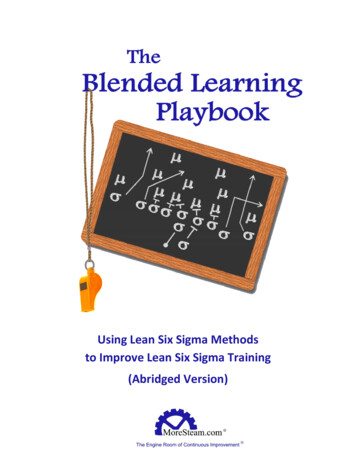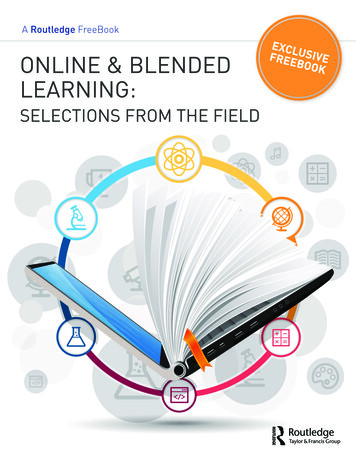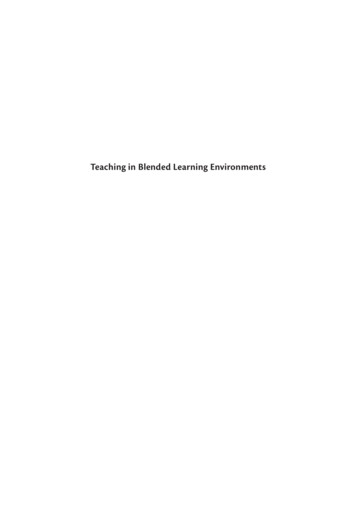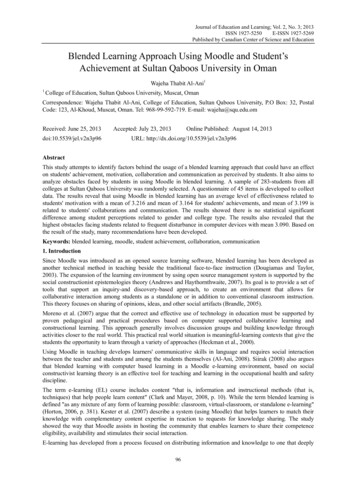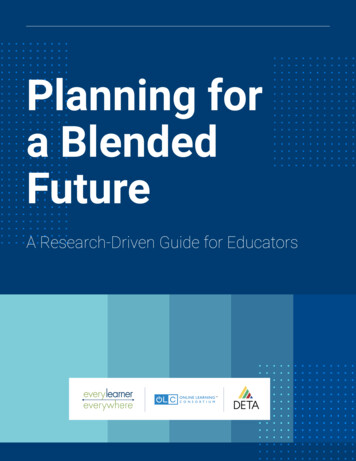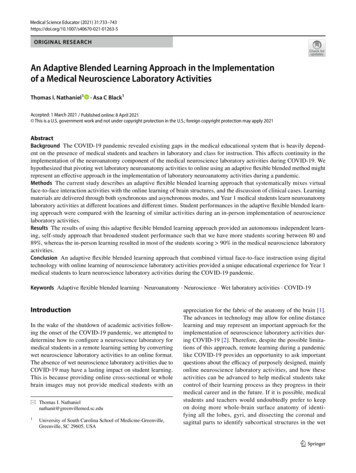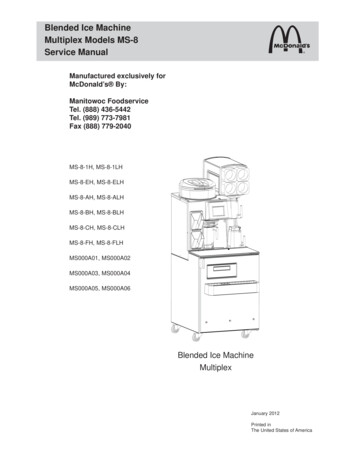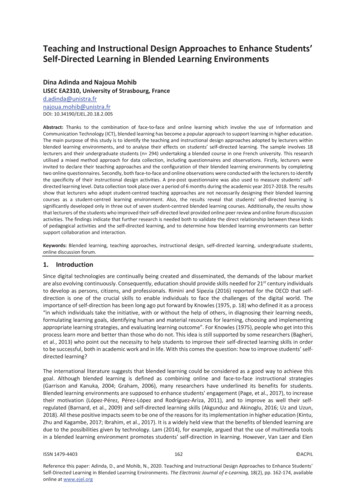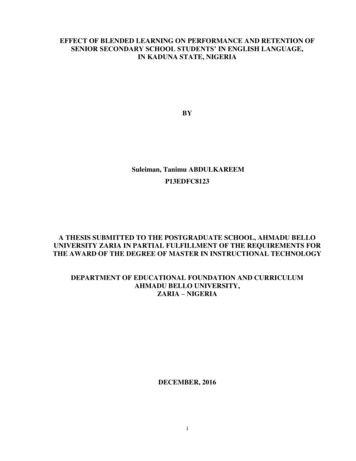
Transcription
EFFECT OF BLENDED LEARNING ON PERFORMANCE AND RETENTION OFSENIOR SECONDARY SCHOOL STUDENTS’ IN ENGLISH LANGUAGE,IN KADUNA STATE, NIGERIABYSuleiman, Tanimu ABDULKAREEMP13EDFC8123A THESIS SUBMITTED TO THE POSTGRADUATE SCHOOL, AHMADU BELLOUNIVERSITY ZARIA IN PARTIAL FULFILLMENT OF THE REQUIREMENTS FORTHE AWARD OF THE DEGREE OF MASTER IN INSTRUCTIONAL TECHNOLOGYDEPARTMENT OF EDUCATIONAL FOUNDATION AND CURRICULUMAHMADU BELLO UNIVERSITY,ZARIA – NIGERIADECEMBER, 2016i
DECLARATIONThis dissertation titled: “Effect of Blended Learning on Performance and Retention of SeniorSecondary School Students in English Language in Kaduna State, Nigeria” was carried out byme. It is a record of my own research work and it has not been presented in any previousresearch work for degree or higher degree. All sources of information and quotations are fullyacknowledged by means of reference.ABDULKAREEM, Suleiman TanimuSignatureiiDate
CERTIFICATIONThis dissertation titled: effect of blended learning on performance and retention of seniorsecondary school students‟ in English language in Kaduna state, Nigeria by Suleiman, TanimuABDULKAREEM, meets part of the requirements governing the award of degree of Masters inInstructional Technology of Ahmadu Bello University, Zaria and is approved for itscontribution to knowledge and literary presentation.Prof. A. K. Tukur(Chairman, Supervisory Committee)Dr. A. I. Gambari(Member, Supervisory Committee)Prof. B. A. Maina(Head of Department)Prof. K. Bala(Signature)(Signature)(Signature)(Dean, School of Postgraduate Studies) (Signature)iii(Date)(Date)(Date)(Date)
ACKNOWLEDGMENTIn the name of Allah, the Beneficent, the Merciful, Peace and blessing of Allah be uponthe Prophet Muhammad and on his relatives, companions and his followers – Ameen.I owe countless thanks to Almighty Allah for His inspirations, wisdom, knowledge andunderstanding granted upon me, throughout my academic pursuits.Many individuals and organizations have contributed in one way or the other to thesuccessful completion of this work. To them, I am very grateful. However, some individualsand organizations are worthy of specific mentioned. Among the individuals first and foremostare my supervisors, Prof. A. K. Tukur and Dr. A. I. Gambari, for their valuable time andcontribution, guidance and whose despite their tight programmes read and made usefulsuggestions and corrections that were of immense benefits to me throughout the write – up.I am grateful and highly indebted to my Head of Section; Dr. S. A. Zubair for hisimmense suggestions, guidance and cooperation without which the success of this work wouldnot have been possible.I am also grateful and indebted to my Head of Department Prof. B. A. Maina, and tomembers of my examination committee; Prof. M.O. Yusuf, Prof. M. Abdullahi, Dr. A. Dada,Malam M. Shehu, U. A. Ginga and Malam A. Dahiru. Their academic expert criticisms andadvice did much to shape the course of this study. I will like to express my heart-felt gratitudeto Prof. Hassan Zoaka, ABU, Zaria.Among the organizations, my profound gratitude goes to, National Teachers‟ Institute,Kaduna authorities who gave me the official permission to undergo the programme. My thanksand appreciation goes to Kaduna State Ministry of Education, Air force Base Secondary School,Kaduna, Government Day Secondary School Rigachikun, Government Secondary SchoolU/Sarki and Government Secondary School T/W/Kaduna for the assistance rendered in thecourse of the study.I throw kudos to my parents, their encouragement and advice were wonderful, to mybrothers, sisters and friends I say thank you, my wives, my children (Fateema-Zahra andMuhammad) who were praying for the successful completion of this work. And Almighty AllahHas answered their prayers.iv
Finally, I wish to also acknowledge with gratitude the individuals and organizationswhose work have been utilized and quoted as reference in the study.v
DEDICATIONThis research study is dedicated to Almighty Allah for the gift of life and sound health and alsothe opportunity to complete the study. Also dedicated to my beloved parents, wives, childrenand teachers, nothing compares to you. You are my source of inspiration.vi
ABSTRACTThis study investigates the effects of blended learning on performance and retention ofsenior secondary school students in English Language in Kaduna State. To give purpose,direction to the study, four objectives, four research questions and four hypotheses wereformulated to guide the study. The diverse views of other related literatures (concepts, theoryand empirical studies) were reviewed. The study adopted a quasi-experimental pre-test, posttest, control group design. The participants of the study consist of 61 males and 111 females(172) students sampled from the SSII stream of two schools, Government Day SecondarySchool Rigachikun was the experimental group, located in the rural area of the state, whileGovernment Secondary School Unguwan Sarki was the control group, located in the urban area.Purposive sampling technique was used to select intact classes used for the study.Two instruments were developed to guide the study. Blended Learning Package (BLP) ateacher-directed interactive instructional package which contains lessons structured inaccordance with SSII, English Language syllabus particularly for 2nd and 3rd term. BlendedLearning Package contains the following topics Sentence Structure, Letter Writing,Comprehension and phonology in conformity with the Nigeria Senior Secondary Schoolcurriculum. While English Language Achievement Test (ELAT) instrument is a 40-item,Multiple-choice objective test instrument with four options a-d, to which the students respondedto or before (i.e. as a pre-test) and after treatment (using Blended Learning Package), it wasdesigned to measure specific learning outcomes related to the contents of the study as containedin (BLP) and were validated using the context form of validation, by Experts in ABU, Lecturersin the Department of Foundation and Curriculum. Descriptive statistics of mean and standarddeviation were used to answer the research questions while inferential statistics of independentvii
sample t-test was used to analyze the hypotheses using SPSS IBM version 20. 0.05 level ofsignificance was used as the basis for which the hypotheses was rejected or not rejected.The findings indicate that technology does not enhance learning until it is supported by thoseconditions of learning such as factual information and learners‟ cognitive skills, especially thelearners‟ ability to read, write, recall past experience and relate to new information.It recommended that for effective teaching and learning, teachers at all levels must beencouraged and trained to ensure learners acquire the essential, rudiments and skills of readingand writing, this is necessary for effective teaching and learning in all disciplines with orwithout technology.viii
OPERATIONAL DEFINITION OF TERMSThe section gives the description of the prepared words as follows:Blended Learning: Is the combining of two different education models, traditional face to facelearning and electronic learning to smooth the progress of teaching and learning objective.Performance: Is the outcome of the tests that was administered on the students before and afterthey have been taught English language with Blended learning and Traditional method.Retention: Is the ability of students to recall or recognize what has been learned or experiencedin their memory. It is also the capacity to remember what they have been taught in Englishlanguage with Blended learning and Traditional method.School Location: refers to the geographical position and the configuration of students‟population in the schools particularly in terms of urban and rural setting.Urban Area: refers to a city with high population density and infrastructure of builtenvironment.Rural Area: refers to a geographical area that is located outside towns and cities. Typical ruralareas have a low population density and small settlements.ix
ABBREVIATIONSBLP: Blended Learning PackageCAI:Computer Assisted InstructionCBL: Computer Based LeaningCBI:Computer Based InstructionELAT: English Language Achievement TestESL: English as Second LanguageESP: English for Specific PurposesFCT: Federal Capital TerritoryFME: Federal Ministry of EducationFRN: Federal Republic of NigeriaGDSS: Government Day Secondary SchoolGSS: Government Secondary SchoolICT:Information and Communication TechnologyISD:Instructional System DesignMDG: Millennium Development GoalsMTN: Mobile Telecommunication NetworkNECO: National Examination CouncilsNERDC: National Educational Research and Development CouncilODL: Open and Distance LearningPLATO: Programmed Language and Automatic TeachingSSCE: Senior Secondary Certificate ExaminationUNESCO: United Nation Educational Scientific and Cultural OrganizationUTME: University Tertiary Matriculation Examinationx
TABLE OF CONTENTSTitle vDedicationviAbstractviiOperational Definition of TermsixAbbreviationsxTable of ContentsxiList of TablesxivList of FiguresxvCHAPTER ONE: INTRODUCTION1.1Background to the Study11.2Statement of the Problem51.3Objectives of the Study71.4Research Questions81.5Research Hypotheses81.6Basic Assumptions81.7Significance of the Study91.8Scope of the Study10CHAPTER TWO: REVIEW OF THE RELATED al Framework112.2.1 Concept of Blended Learning112.2.2Blended Learning Characteristics152.3Information and Communication Technology192.3.1 E-Learning252.428Concept of Academic Performancexi
2.5.Computer Application in Education292.5.1Brief History of Computer in Nigerian Education System302.5.2Nature and Objective of English Language Curriculum332.6Instructional Designs, Theories and Models362.7Empirical Studies422.7.2 Blended learning, Gender, Students Academic Performance and Retention432.846Summary of the Review of Related LiteratureCHAPTER THREE: METHODOLOGY3.1Introduction483.2Research Design483.3Population of the Study493.4Sample and Sampling Techniques493.5Instrumentation503.5.1 Validity of Research Instruments513.5.2 Reliability of the Instruments523.5.3Pilot Testing523.6Procedure of Data Collection523.7Procedure of Data Analysis53CHAPTER FOUR: DATA PRESENTATION AND ing Research Questions554.3.1 Research Question One554.3.2 Research Question Two554.3.3 Research Question Three564.3.4 Research Questions Four574.458Hypotheses Testing4.4.1 Hypotheses One584.4.2 Hypotheses Two594.4.3 Hypotheses Three59xii
4.4.4 Hypotheses Four604.5Summary of Major Findings614.6Discussion of Findings61CHAPTER FIVE: SUMMARY, CONCLUSION AND RECOMMENDATIONS5.1Introduction675.1.1Summary of the Study675.2Conclusion695.2.1 Implication of the Findings705.3Recommendations715.4Suggestions for further Studies72References73Appendices86xiii
LIST OF TABLESTable 3.3.1Distribution of SSII Students Population among twelve educational zones 49Table 3.5.2.1 Distribution of questions in ELAT based on SSII syllabus51Table 4.2.1Distribution of respondents by gender54Table 4.2.2Distribution of respondents by retention54Table 4.3.1Distribution of respondents by their performance55Table 4.3.2Mean and standard deviation of respondents according to their retention56Table 4.3.3Mean and standard deviation of respondents based on gender56Table 4.3.4Mean and standard deviation of respondents based on gender retention57Table 4.4.1Difference between students taught English language with BlendedLearning and those exposed to traditional methodTable 4.4.258Difference in retention of students exposed to blended learning and thoseexposed to traditional method59Table 4.4.3Difference in performance of students based on gender60Table 4.4.4Difference in retention level of male and female students taught Englishlanguage using blended learningxiv60
LIST OF FIGURES2.1Concept map of Blended Learning142.2Hannafin and Peck Instructional Design Model422.3Knirk and Gustafson Instructional Design Model42xv
CHAPTER ONEINTRODUCTION1.1Background to the StudyIn this knowledge age, in which technology has been advancing and information has beenrapidly increasing and refreshing, teachers working in educational environments requires moreefforts to provide students with information by using effective technology based methods.It is abasic educational principle that teaching and learning is best achieved when generalizations andtheoretical concept are developed through experience of a vivid and realistic kind. The effect ofblended learning in the classroom presentation is also vital in every aspect of teaching andlearning for good academic performance and retention (Kurtus, 2004).English Language is a compulsory subject offered at the Senior Secondary School Levelin Nigeria. According to Oyetunde (2006) English language is an Indo-European languagebelonging to the West Germanic branch; the official language of Britain and the United Statesand most of the commonwealth countries. In Nigeria it is the official language, the languages oflaw, government, education and international communication. In Nigerian educational system,English language is the medium of instruction in all educational institutions and also industrialand business training centre. It is an important subject in the school curriculum at the primary,secondary and tertiary levels of education in Nigeria.The national policy on education (Federal Republic of Nigeria, 2013) regards education asan instrument for effecting national development. The Nigerian philosophy on education isbased on the development of the individual into a sound and effective citizen and the provisionof equal education opportunities for all citizens of the national at the primary, secondary andtertiary levels both inside and outside the formal system. The Federal Government laid downpolicy on English language for the whole country is that; in primary school, which lasts six1
years, each child must study two language; English language and his mother tongue (if availablefor study) or an indigenous language of wider communication in his area of residence.In secondary school which is six years duration, the child must study two language, Englishlanguage and indigenous language. In tertiary institutions the child must study English languageunder the general studies.Since Nigeria's independence in 1960, conscious efforts towards improving the teachingof English and the review of curriculum have been made. Education in Nigeria is the sharedresponsibility of the federal, state and local governments. According to Oyetunde (2006)The Federal Ministry of Education plays a dominant role in regulating the education sector,engaging in policy formation and ensuring quality control. However, the federal government ismore directly involved with tertiary education than it is with school education, which is largelythe responsibility of state (secondary) and local (primary) governments.The education sector is divided into three sub-sectors: basic (nine years), post-basic/seniorsecondary (three years), and tertiary (four to seven years, depending on the major or course ofstudy). Education in Nigeria is provided by public and private institutions. According tonational policy on education (FRN, 2013), basic education covers education given to children 315 years of age, which includes pre-primary programs (ages three to five), and nine years offormal (compulsory) schooling consisting of six years of primary and three years of juniorsecondary. Post-basic education includes three years of senior secondary education in either anacademic or technical stream. Continuing education options are provided through vocationaland technical schools.The common core curriculum at the senior secondary level consists of: English, oneNigerian language, mathematics, one science subject, one social science subject, andagricultural science or a vocational subject. In addition, students must take three elective2
subjects, one of which may be dropped in the third year. The national policy on education(FRN, 2013) identified that students take the Senior Secondary Certificate Examination (SSCE)at the end of SS III. The Senior Secondary Certificate (SSC) is awarded to successfulcandidates. The certificate lists all subjects in which the student is successful. The SSC is issuedby the West African Examination Council(WAEC) or the National Examination Council(NECO), depending on the examination board used. An average grade of „credit‟ level (C6) orbetter is required for access to public universities; however some require higher grades foradmission. The standard of the two examinations are essentially the same. Students register fora maximum of nine and a minimum of seven subjects, which must include English language andMathematics. A student must get at least a C in English and four other courses relevant to his orher major in order to sit for the University Tertiary Matriculation Examination (UTME). Astudent applying for admission to study medicine, computer science or accounting, for example,will be required to have a minimum of a C in English language as well as in Mathematicswhereas a student applying for a program in history will not necessarily require a C inmathematics.The method for transmitting language skills has remained too theoretical and devoid, andthe use of technology to stimulate the learners‟ interest and sustain their necessary skills isrequired. Therefore, undermining the spirit and the fundamental objectives of the subject matter;English Language. This assertion is drawn from the perspectives of failures in schoolexamination which may be ascribed to factors guiding teaching and learning which includearchaic pedagogical approaches that not in tune with global practices (Gredler, 2007).A stronger learning environment has emerged with combining the strongest aspects of thetwo available approaches to remove the deficiencies of traditional learning and Web-basedlearning. This new learning approach is blended learning. In international literature it is also3
referred as hybrid learning and mixed learning and it is used in very different ways by manyresearchers. Rossett, Disocroll and Singh, (2003) defines blended learning as integrating face toface learning and electronic learning or distance learning, using difference learning theories,methodologies and techniques in the same place and supporting the learning with various onlinetechnologies during the learning process in the classroom. Blended learning can also be definesas the combining of the two different education models, traditional face to face learning anddistance learning(Graham, 2006).Throne (2003), on the other hand, defines the blended learning as “an education modelwhich can integrate e-learning which has improved in parallel with new and technologicdevelopments with traditional learning which provides the interaction in classroom”. Wilsonand Smilanich (2005) see the blended learning as “the implementation of the most effectivelearning solutions in a coordinated way to achieve the desired learning targets”. While Horton(2000) defines it as “combining some strong and advantageous aspects of online learning andthe learning in classroom” and Morgan (2002) explains that blended learning is conducted toblend the best aspects of online learning and face to face learning.Blended learning is a new type of education prepared for a certain group by combining thepositive aspects of different learning approaches. Blended learning will provide a bigconvenience for the course to achieve its target by combining the face to face interaction intraditional learning and time, place and material richness provided by Web-based learning.Yılmaz and Orhan (2010) state that the best way to solve the lack of interaction problem facedin technology-based learning is to blend traditional learning and online learning. Throne(2003)emphasizes that the blending of these two learning approaches occurs by combiningcomputers, CD ROM, e-mail, conference, online animation, audio message, multimedia4
technology and real classroom environment and he states that it should be presented to thestudent with traditional classroom management and face to face learning.From this point of view, blended learning can be a good solution by offering differentlearning environments to the students who have individual differences as well as approaches tolearning. Besides, blended learning is a learning approach formed with the combination of thedifferent learning environments and activity types for a certain group with the addition ofInformation and Communication Technology (ICT) to the face to face learning (Bersin andAssociates, 2004). This approach has the facilities to meet the learning necessities of the era.The fact that it is applicable and renewable, and it has the technological innovations that arebrought by our modern age stands as a proof approach which is worthy of teaching andlearning.1.2Statement of the ProblemThe convergence of the global technology has produced an environment in which themedium for instruction could change (Wagner, 2008). The 21st Century philosophy of teachingand learning is „child-centred‟ as such; blended technique is organized to compliment theteacher whose role is that of a „guide on the side not a sage on the stage‟ (Christman & Badget,2012) as it was the practice. However, most secondary school teachers in Nigeria are used to thetraditional (chalk-talk) method of teaching which renders students passive listeners and maketeaching ineffective, consequently affecting the students‟ performance in English Languageparticularly.On the other hand, the state of knowledge explosion with increasing specialization,increase in student-teacher ratio and increase in workload of teachers, classroom instruction5
alone does not in most cases bring out the desired goals from the teaching and learning process,this causes some drawbacks in student performance in English Language.From the few researches carried out in the area of English language in Nigeria, there isnone specifically in the area of blended learning for Nigerian secondary school students. Amongfew researches carried out in the area of English languages include those of Adewumi (2010)which evaluates the use of computer in English language programme in Ilorin High SecondarySchool, in order to determine its relevance, suitability appropriateness to the academic, socialand professional needs of Nigerian secondary schools. Tinuoe‟s (2013) also investigated thevariability, effectiveness and appropriateness of the computer programming to the Englishlanguage needs of Nigerian secondary school students. All these previous works more or lessare in the area of computer, need and analysis, but none is specifically in the area of blendedlearning for Nigerian secondary schools as earlier mentioned.Academic performance represents the results of education, it is the outcomes thatindicate the extent to which a person has accomplished specific goals that were the focus ofactivities in instructional environments, specifically in school, college, and university. Schoolsystems mostly define cognitive goals that either apply across multiple subject areas (e.g.,critical thinking) or include the acquisition of knowledge and understanding in a specificintellectual domain (e.g., language, literature, science, history). Academic performancemeasured in a number of ways such as, oral and written tests; presentations, assignments, classwork, projects and continuous assessment. Other forms of evaluating student‟s academicperformance include; standardized tests and teacher-made tests. There is universal agreementthat a major criterion of technological implementation in schools should be whether suchapplications actually to improve teaching and learning and improve students‟ academic6
performance. However, there is a consensus about the complexity and challenge of reliablyevaluating the impact of technology. (Noeth & Volkov, 2004).An investigation into the average performance of Senior Secondary students that offeredEnglish Language in Senior Secondary Certificate Examination (SSCE) in Kaduna State from2013 – 2015 academic sessions indicated very poor performance. See appendix 1.1,(KadunaState Ministry of Education, 2015). These records indicate that students performed poorlyindeed and this raised serious cause for concern considering the huge resources expended byGovernment at different levels to improve the standard of education in Nigeria as a whole andKaduna State in particular. The importance of English language to the development of art andlanguages in Kaduna state in particular and Nigeria at large makes it necessary to exploreavailable strategies to improve teaching and learning of English language. Since learning can becontextualized, Blend techniques may be the medium to facilitate students‟ better learning ofEnglish language.1.3Objectives of the StudyThe main objective of this study is to examine the effect of blended learning onPerformance and Retention of senior secondary school students‟ in English language in Kadunastate, Nigeria. Specifically, the study will achieve the following objectives:(i)Find out the effect of blended-learning on performance of senior secondary schoolstudents in English language.(ii)Find out the effect of blended learning on secondary school students retention in Englishlanguage.(iii)Find out the influence of gender on the performance of students exposed to Blendedlearning.7
(iv)Find out the influence of gender on the retention of students in English language usingBlended learning.1.4Research QuestionsThe following research questions were raised to guide the study:(i)What is the difference between the performance of students taught English languagewith blended learning and those taught with traditional method?(ii)What is the difference between the retention of students taught English language withblended learning and those taught with traditional method?(iii)What is the difference between the performance of male and female students taughtEnglish Language with Blended-learning?(iv)What is the difference between the retention of male and female students taught Englishlanguage with Blended learning?1.5Null HypothesesThe following hypotheses were formulated and tested at p 0.05 to guide the study:Ho1:Thereis no significant difference between the performance of student exposed to Englishlanguage using blended learning and those exposed to traditional method.Ho2:There is no significant difference in the retention of students exposed to blendedlearning and those exposed to traditional method.Ho3:There is no significant difference between the performance of male and female studentstaught English Language using Blended-learning.Ho4: There is no significant difference between the retention of male and female studentstaught English Language using Blended learning.8
1.6Basic AssumptionsIn carrying out this study, it was assumed that:(1)Secondary schools in Kaduna state were using the same curriculum for English language.(2)Schools used for the study were adequately equipped with ICT facilities such ascomputer and internet connectivity.(3)Schools selected had computer literate teachers who can easily adapt to blended learningtechnique.(4)1.7Students for the schools chosen have been exposed to the use of computer for learning.Significance of the StudyThe findings of this study may be of benefit to the students, teachers, policy makers,curriculum planners, and textbook writers:Students may gain from blended-learning package for English Language. The gainincludes; better and comfortable learning, towards learning with computers, mobile phones,internet, e-mail, and so on in which they learn at their own speed and convenience. They alsohave opportunities to work vastly superior materials and more sophisticated problems;personalized tutoring; and automatic measurement of progress.Teachers may benefit from blended-learning package for English Language, as theyexperience less hard work and repetition, greater ease in updating instructional materials, moreaccurate appraisal and documentation of students‟ progress, easily to catch the learner interestand more time to work directly with student.Basically, the study could serve as a reference material for further studies in theapplication of blended-learning to teaching and learning. Especially in arts and languagesEducational software developers could mass produce blended-learning package for use by9
senior secondary schools teachers and students to enhance the teaching and learning of Englishlanguage in senior secondary schools.Also, the study could benefit curriculum planners to plan and designed adequate andsuitable curriculum for the students at various levels, applying the modern technique (method)that save time and engage the students and easy to achieved the targeted yearning andaspiration.1.8Scope of the StudyKaduna State Secondary School education is structured into 12 educational zonesnamely: Anchau, Birnin-Gwari, Giwa, Godogodo, Kachia, Kaduna, Kafanchan, Lere,Rigachikun, Sabon Tasha, Zaria and Zonkwa respectively. This study was limited to SeniorSecondary Schools in Kaduna State. It focused on SS II students of Government SecondarySchool Unguwan Sarki (Urban school) and Government Day Secondary School Rigachikun(Rural school), Rigachikun zone. This class is the most suitable for this study because they are aconsistent middle class in the SS stream, they have less tendency for distraction because theyhave only the terminal examination of writing English and have covered the most of the EnglishLanguage syllabus.This study was limited to four topics in English language which included: SentenceStructure (simple, compound and complex sentence),
a thesis submitted to the postgraduate school, ahmadu bello university zaria in partial fulfillment of the requirements for the award of the degree of master in instructional technology department of educational foundation and curriculum ahmadu bello university, zaria - nigeria december, 2016
